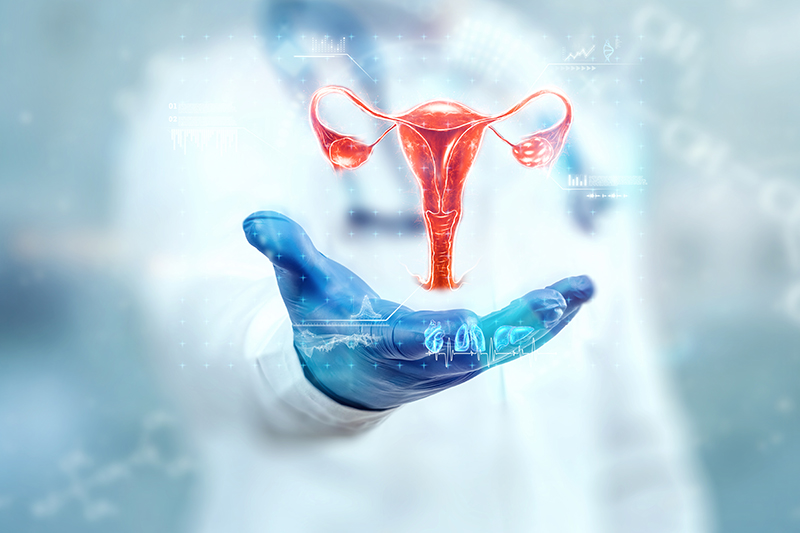Endometriosis is a painful disorder that occurs when tissue similar to the lining of the uterus (endometrium) grows outside of the uterus. The most common sites of endometriosis are – ovaries, fallopian tubes, ligaments that support the uterus and the tissue lining the pelvis. This endometrial-like tissue can also develop in other areas including the digestive tract, the lungs, rectum, cervix or the vulva. Obstetrics and gynecology medical coding involves reporting this condition on physicians’ medical claims using appropriate diagnosis and procedure codes. The three main types of endometriosis are superficial peritoneal lesion, endometrioma (ovarian lesion), and deeply infiltrating endometriosis.
The tissue responds to hormones that affect the menstrual cycle in the same way the endometrial tissue does. Though it swells and bleeds like endometrial tissue, there is nowhere for the waste tissue and blood to go, increasing the chances for the tissues to block the fallopian tubes, and thus form cysts due to trapped blood.
Symptoms, Causes, Diagnosis and Treatment for Endometriosis
The primary symptom of endometriosis is pelvic pain, related to painful menstrual periods, pain with intercourse, abnormal or heavy menstrual flow or bleeding, pain with bowel movements or urination, infertility, fatigue, diarrhea, constipation, bloating or nausea, and more. With such symptoms, endometriosis is sometimes mistaken for other conditions that can cause pelvic pain, such as pelvic inflammatory disease (PID) or ovarian cysts.
Possible causes of endometriosis include retrograde menstruation, transformation of peritoneal cells, embryonic cell transformation, surgical scar implantation, endometrial cell transport, or immune system disorder.
Diagnosis begins with a gynecologist or other provider evaluating a patient’s medical history and completing a physical examination, including a pelvic exam. An early diagnosis helps in better management of the symptoms related to this condition. Diagnostic tests that are recommended to check for physical clues of endometriosis include pelvic exam, ultrasound, Magnetic resonance imaging (MRI), and laparoscopy. Laparoscopy is the major diagnostic procedure to definitively diagnose and treat endometriosis. During the test, a thin tube with a camera at the end is inserted into the abdomen through a small incision, to determine the location, extent and size of the endometrial growths.
There are 4 stages of endometriosis such as – Minimal, Mild, Moderate or Severe. The stage of the condition is classified based on the location, amount, depth and size of the endometrial tissue.
Treatment options include pain medications (NSAIDs – ibuprofen or other over-the-counter analgesics), hormone therapy (oral contraceptive pills, GnRH agonists, progestin-containing compounds, danazol) and surgical destruction of lesions (Laparotomy or Hysterectomy). Controlled ovarian hyperstimulation and IVF may be considered for patients with subfertility.
While laparotomy is an extensive surgery to remove as much of the displaced endometrium without damaging healthy tissue, hysterectomy is the procedure to remove the uterus and possibly the ovaries. The right treatment option will be recommended based on factors such as the patient’s overall health, medical history, current symptoms, desire for pregnancy and more.
Endometriosis Medical Coding
ICD-10 Codes
- N80 Endometriosis
- N80.0 Endometriosis of uterus
- N80.1 Endometriosis of ovary
- N80.2 Endometriosis of fallopian tube
- N80.3 Endometriosis of pelvic peritoneum
- N80.4 Endometriosis of rectovaginal septum and vagina
- N80.5 Endometriosis of intestine
- N80.6 Endometriosis in cutaneous scar
- N80.8 Other endometriosis
- N80.9 Endometriosis, unspecified
CPT Codes
Laparoscopic endometriosis code
- 58662: “Laparoscopy, surgical; with fulguration or excision of lesions of the ovary, pelvic viscera, or peritoneal surface by any method.”
If the procedure for removal of the endometriosis extends to more than 80 minutes, modifier 22 should be reported on the claim. CPT defines this modifier as “When the work required to provide a service is substantially greater than typically required, it may be identified by adding modifier 22 to the usual procedure code.” It is also important for the documentation to support the substantial additional work and the reason for the additional work such as – increased intensity, time, technical difficulty of procedure, severity of patient’s condition, and the physical and mental effort required. When relying on a medical coding company, it is important to ensure that the coding staff can assign the codes and modifiers related to the procedure in an appropriate way.




